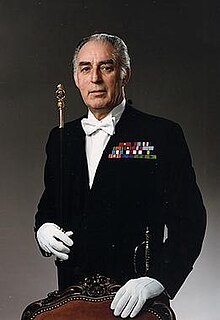René Jalbert
René Jalbert | |
|---|---|
 Jalbert while serving as Black Rod | |
| 10th Gentleman Usher of the Black Rod | |
| In office July 1985 – March 1989 | |
| Prime Minister | Brian Mulroney |
| Preceded by | Claude Lajoie |
| Succeeded by | |
| Sergeant-at-Arms of the National Assembly of Quebec | |
| Personal details | |
| Born | 20 February 1921 |
| Died | 21 January 1996 (aged 74) |
| Resting place | Quebec City, Quebec |
| Awards | Cross of Valour, 1939–1945 Star, France and Germany Star, Defence Medal, Canadian Volunteer Service Medal with Overseas Clasp, 1939–45 War Medal, United Nations Korea Medal, United Nations Medal for Cyprus, International Commission for Supervision and Control Medal, Queen's Silver Jubilee Medal, Canadian Forces Decoration with 22-year clasp. |
| Military service | |
| Branch/service | Canadian Army |
| Years of service | c. 1939-1969 |
| Rank | Major |
| Unit | Royal 22nd Regiment |
| Battles/wars | |
René Marc Jalbert CV CD (20 February 1921 – 21 January 1996) was a retired Canadian Forces officer and sergeant-at-arms of the National Assembly of Quebec, known for his role in ending Denis Lortie's killing spree in the Parliament Building on 8 May 1984. Later he served as Usher of the Black Rod for the Parliament of Canada.
Military career[]
Jalbert served in World War II and the Korean War, ultimately attaining the rank of major in the Royal 22e Régiment.
Sergeant-at-arms[]
After his military career, he served as sergeant-at-arms in the National Assembly of Quebec.
On 8 May 1984, Denis Lortie entered the Parliament Building in the morning, before government business had begun, killing three government employees and wounding 13 others on his way to the Assembly Chamber. Upon learning of Lortie's presence, Jalbert entered the Assembly Chamber. Seeing Lortie in uniform, Jalbert showed the gunman his identification as a military veteran, opening a dialogue with him. Jalbert convinced Lortie to allow several employees to leave the premises. Then he invited Lortie into his downstairs office to discuss the situation, in effect setting himself up as hostage while removing Lortie from the scene. At extreme personal risk, Jalbert spent four hours persuading Lortie to surrender to police.
Jalbert's actions almost certainly prevented a higher death toll. For his bravery, Jalbert was awarded the Cross of Valour, Canada's highest civilian award for bravery, which was presented to him 9 November 1984, by Governor General Jeanne Sauvé in a ceremony at Rideau Hall, Ottawa.
The award citation reads:
In a rare display of coolheadedness and courage, René Jalbert, Sergeant-at-Arms at the Quebec National Assembly, subdued a man who had killed three people and wounded thirteen more on the morning of 8 May 1984. The man had entered a side door of the National Assembly building and immediately opened fire with a submachine-gun; moments later he climbed the main staircase toward the assembly chamber, known as the Blue Room, shooting repeatedly, and then burst into the chamber. As bullets peppered the wall, Mr. Jalbert entered the Blue Room and with icy calm convinced the man to allow several employees to leave the premises. Then he invited the heavily armed man into his downstairs office, in effect setting himself up as hostage while removing the man from the scene. At extreme personal risk, but with unflinching authority, Mr. Jalbert spent four hours persuading the man to surrender to police. The audacity of this retired Major of the Royal 22nd Regiment, a Second World War and Korean War veteran, almost certainly prevented a higher death toll.[1]
Usher of the black rod and legacy[]
From July 1985 to March 1989, Jalbert was Usher of the Black Rod in the federal Parliament of Canada in Ottawa, the most senior protocol position in the Parliamentary staff.
Jalbert died at age 74 in 1996. His younger brother was film and television actor Pierre Jalbert, who died in 2014.
In 2006 a street in Quebec City was named after René Jalbert.[2]
Awards and decorations[]
Jalbert's personal awards and decorations include the following:
| Ribbon | Description | Notes |
| Cross of Valour (Canada) (CV) |
| |
| WW2 1939–1945 Star |
| |
| WW2 France and Germany Star |
| |
| WW2 Defence Medal (United Kingdom) |
| |
| WW2 Canadian Volunteer Service Medal |
| |
| WW2 War Medal 1939–1945 |
| |
| Canadian Volunteer Service Medal for Korea | ||
| Special Service Medal |
| |
| Korea Medal |
| |
| United Nations Medal |
| |
| International Commission for Supervision and Control Medal |
| |
| Queen Elizabeth II Silver Jubilee Medal |
| |
| 125th Anniversary of the Confederation of Canada Medal |
| |
| Canadian Forces Decoration (CD) |
|
References[]
- ^ "M. René Marc Jalbert, C.V., C.D." Decorations for Bravery. The Office of the Secretary to the Governor General. Retrieved 11 January 2012.
- ^ www.ville.quebec.qc.ca Toponymy
- ^ "Decorations for Bravery List". The Governor General of Canada.
- 1921 births
- 1996 deaths
- Canadian military personnel of the Korean War
- Canadian Army personnel of World War II
- Recipients of the Cross of Valour (Canada)
- Quebec civil servants
- Royal 22nd Regiment officers
- Canadian Army officers